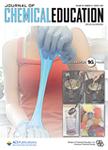版权所有:内蒙古大学图书馆 技术提供:维普资讯• 智图
内蒙古自治区呼和浩特市赛罕区大学西街235号 邮编: 010021

作者机构:Univ Colorado Sch Educ Boulder CO 80309 USA Univ Colorado Dept Phys Boulder CO 80309 USA Univ Colorado Dept Chem & Biochem Boulder CO 80309 USA Univ Colorado JILA Boulder CO 80309 USA
出 版 物:《JOURNAL OF CHEMICAL EDUCATION》 (化学教育杂志)
年 卷 期:2014年第91卷第8期
页 面:1191-1197页
核心收录:
学科分类:0401[教育学-教育学] 07[理学] 0703[理学-化学]
基 金:National Science Foundation [DUE-1226321] Direct For Education and Human Resources Division Of Research On Learning Funding Source: National Science Foundation Direct For Education and Human Resources Division Of Undergraduate Education Funding Source: National Science Foundation
主 题:First-Year Undergraduate/General High School/Introductory Chemistry Elementary/Middle School Science Second-Year Undergraduate Computer-Based Learning Inquiry-Based/Discovery Learning Internet/Web-Based Learning
摘 要:Developing fluency across symbolic-, macroscopic-, and particulate-level representations is central to learning chemistry. Within the chemistry education community, animations and simulations that support multi-representational fluency are considered critical. With advances in the accessibility and sophistication of technology, interactive computer simulations are emerging as uniquely powerful tools to support chemistry learning. In this article, we present examples and resources to support successful implementation of PhET interactive simulations. The PhET Interactive Simulations project at the University of Colorado Boulder has developed over 30 interactive simulations for teaching and learning chemistry. PhET simulations provide dynamic access to multiple representations, make the invisible visible, scaffold inquiry, and allow for safe and quick access to multiple trials, while being engaging and fun for students and teachers. The simulations are readily accessible online, and are designed to be flexible tools to support a wide-range of implementation styles and teaching environments. Here, we introduce the PhET project, including the project s goals and design principles. We then highlight two simulations for chemistry, Molecule Polarity and Beer s Law Lab. Finally, we share examples (with resources) of the variety of ways PhET simulations can be used to teach chemistry in lecture, laboratory, and homework.